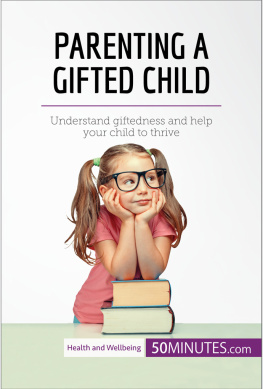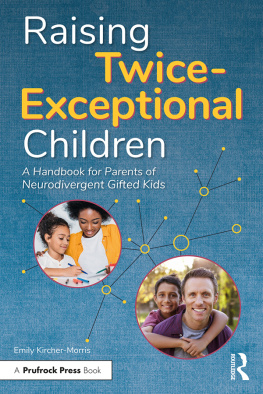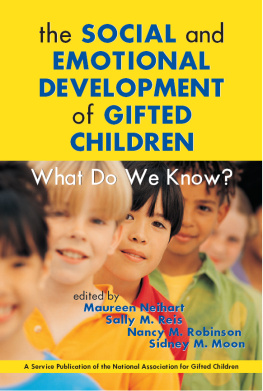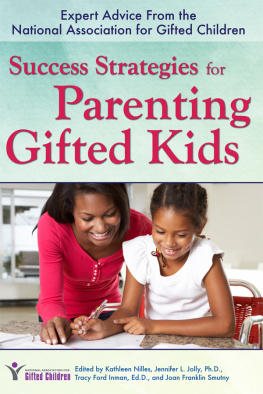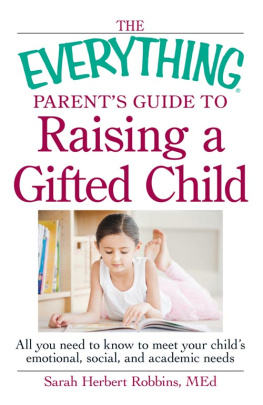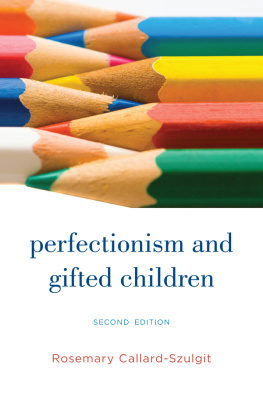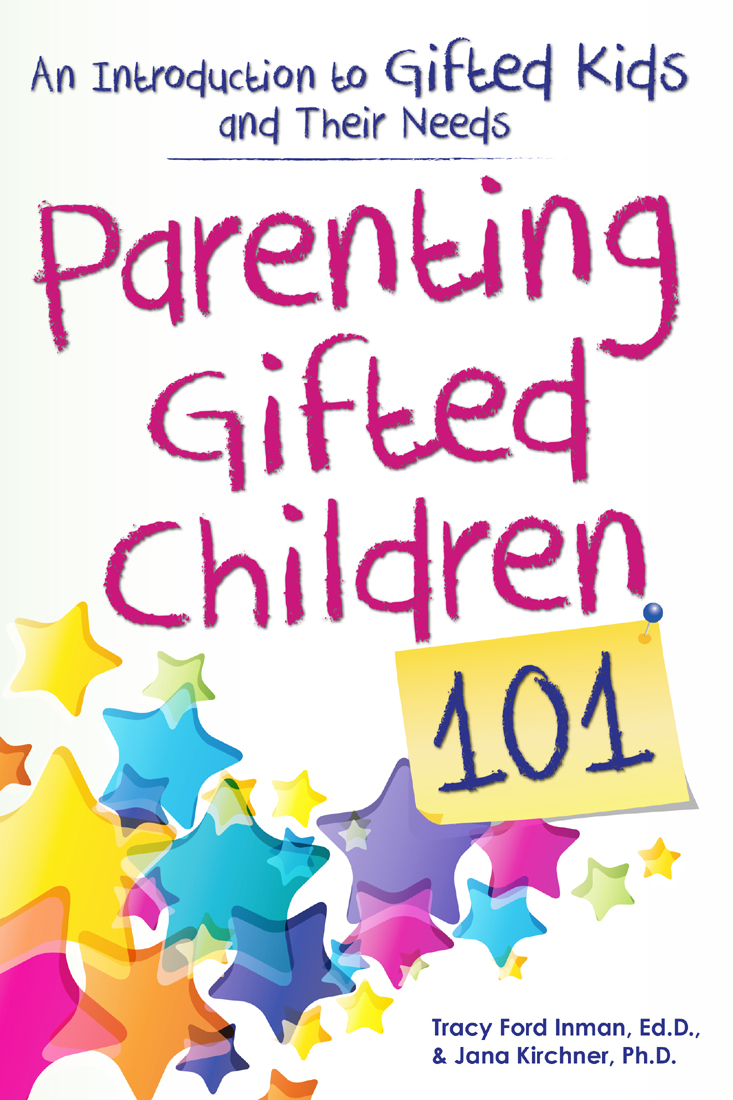


Tracy Ford Inman, Ed.D.,
& Jana Kirchner, Ph.D.

Copyright 2016, Prufrock Press Inc.
Edited by Katy McDowall
Cover design by Raquel Trevino and layout design by Allegra Denbo
ISBN-13: 978-1-61821-520-8
No part of this book may be reproduced, translated, stored in a retrieval system, or transmitted, in any form or by any means, electronic, mechanical, photocopying, microfilming, recording, or otherwise, without written permission from the publisher.
At the time of this books publication, all facts and figures cited are the most current available. All telephone numbers, addresses, and website URLs are accurate and active. All publications, organizations, websites, and other resources exist as described in the book, and all have been verified. The author and Prufrock Press Inc. make no warranty or guarantee concerning the information and materials given out by organizations or content found at websites, and we are not responsible for any changes that occur after this books publication. If you find an error, please contact Prufrock Press Inc.

| Prufrock Press Inc.
P.O. Box 8813
Waco, TX 76714-8813
Phone: (800) 998-2208
Fax: (800) 240-0333
http://www.prufrock.com |
Table of Contents
Acknowledgements
We would like to extend our deepest gratitude to all the administrators, teachers, and parents who took the time to respond to our survey questions and share their insights about gifted children. We feel their stories and experiences are a major strength of our book! Special thanks to Toddie Adams, Angie Barrandeguy, David Baxter, Constance Baynum, Amy Berry, Karen Bickett, Cecelia Boswell, Lynette Breedlove, Jane Bush, Dina Chaffin, Jennifer Chaplin, Debbie Dailey, Anita Davis, Keith Davis, Mary Evans, LaTonya Frazier, Gregory Grey, Tracy Harkins, Claire Hughes, Leslie Hutchinson, Ruth Kertis, Laureen Laumeyer, Andrew McMichael, Jane Paulin, Pam Petty, Mary Cay Ricci, Jennifer Sheffield, Cathleen Skidmore, Kandy Smith, Deborah Strubler, Penny Teague, Kelli Thompson, Melissa Wassom, and Tim Wilson. We are also grateful to Lynette Breedlove, Mary Evans, Leslie Hutchinson, Jenny Robins, and Mary Young for reading the manuscript in progress and providing feedback.
A heartfelt thank you goes to the amazing students that both of us have taught over the last 20-plus years. You challenged us, made us laugh, helped us develop as teachers (and human beings), and learned with us. Many of your stories are examples in this book.
Most importantly, we thank our families who supported and encouraged us during this project. A special thank you goes to our children (Jake and Zach Inman, Caleb and Caitlyn Kirchner) who inspired many of the stories in this book as we figured out how to answer your many questions as preschoolers, to support and encourage your gifts and talents through elementary school, and to nurture and challenge you through your teen and young adult years. We are honored to be your moms and are in awe of the people you have become.
Introduction: Tips for Reading This Book
Failure to help the gifted child reach his potential is a societal tragedy, the extent of which is difficult to measure but what is surely great. How can we measure the sonata unwritten, the curative drug undiscovered, the absence of political insight? They are the difference between what we are and what we could be as a society. (Gallagher, 1975, p. 9)
We couldnt agree more with Jim Gallagher, one of gifted educations patriarchs, so our goal for this book is to help you as parents help your gifted child reach her potential. With that as our focus, we have created a practical, user-friendly book designed to provide information and to empower you to be an effective advocate for your child. Each chapter targets an essential question and answers it with background information, current research, useful tips, connections to home and school, and additional resources. Most importantly, we include insights, stories, and advice from dozens of parents, teachers, and administrators who have experience with gifted children. Unless otherwise noted, these quotes come from parents of gifted children, teachers working directly with gifted children, and district gifted coordinators. Some have dual roles, such as a parent and a teacher. We hope that these authentic voices not only connect on a personal level with you but also teach you important lessons about parenting your gifted child.
You can read this book in a couple of waysfrom beginning to end or by picking and choosing chapters that address your most pressing questions. , entitled How Can I Communicate and Partner With My Childs Educators? and What Can I Do at Home to Help My Child?, however, is an in-depth discussion of implications for school and home. Each chapter also includes a section called For More Information, describing additional print and online resources related to that topic. Full web addresses for any websites mentioned in the chapter are provided. We have also included a glossary so that you have a quick way to define terms when needed.
Our hope is that you will use this book and the additional resources we mention to guide you as you parent your gifted and talented child. Yes, you will face challenges along the way, but you will also experience laughter, joy, and awe as your child develops into the person he could bewhether that is (as in Jim Gallaghers vision) a composer, medical researcher, political leader, or something altogether different.
Chapter
What Does Gifted Mean?
Parents of gifted children should learn all they can about giftedness, be engaged in their students lives, be advocates for their children in schools, be intentional about finding appropriate services outside of the school, and above all, be cautious about their social and emotional needs. Thats a tall order, huh?
Jennifer Chaplin, district coordinator
Either your child (or a young person significant in your life) has been identified as gifted or you suspect that he isotherwise you wouldnt be reading this. In order to understand and appreciate the specifics of social-emotional needs, appropriate learning experiences, effective communication with educators, and all of the other critical topics explored in this book, you need to understand some basics first: what gifted means, the areas of giftedness and identification for each, legislation and policies that affect gifted children, and the rights of gifted children.
Definition
Depending on whom you ask, the phrase gifted and talented can take on a plethora of meanings. The phrase is always evolving, but, ultimately, the most important definitions to know are your states and districts interpretations of gifted and talented because those interpretations directly affect your childs education. In order to have a deeper understanding, however, a brief look at well-known definitions proves helpful.
Next page

